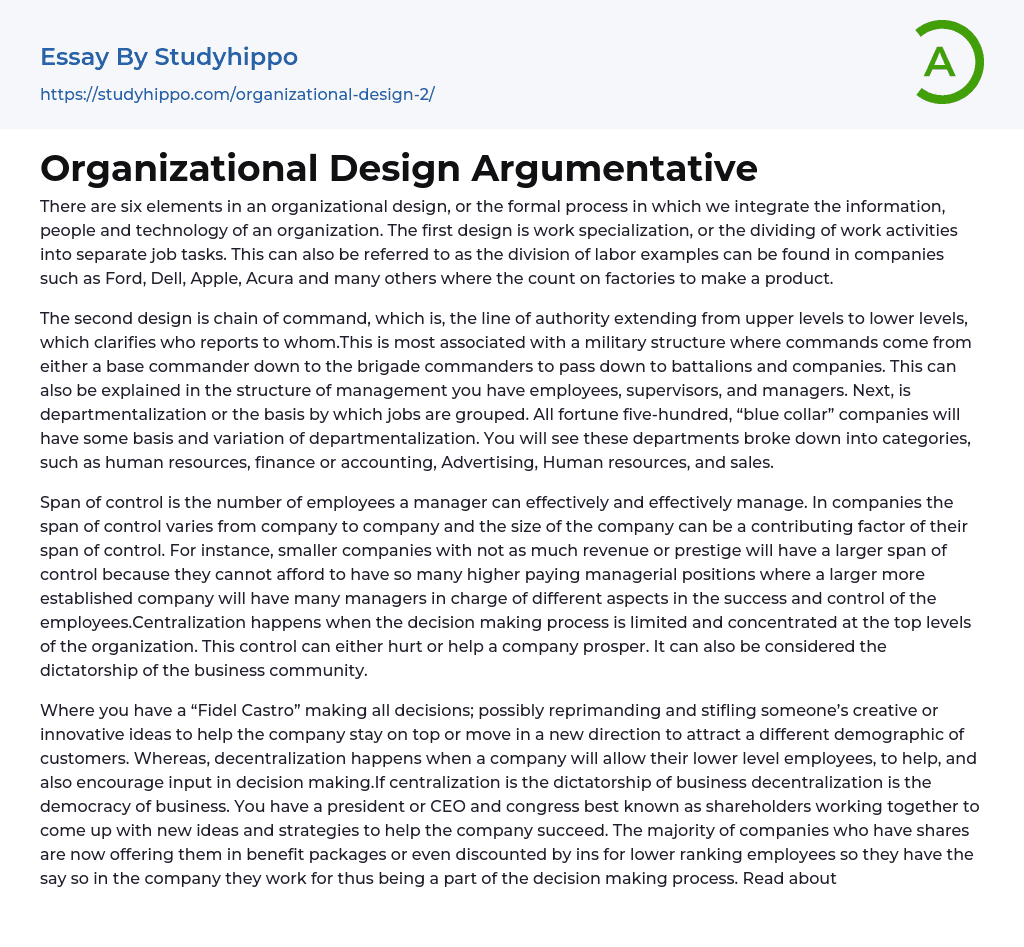Organizational design involves integrating information, people, and technology of an organization in a formal process that encompasses six elements. The first element is work specialization where work activities are divided into separate job tasks, also known as the division of labor. Examples of this can be seen in companies like Ford, Dell, Apple, Acura and others that rely on factories to produce their products.
The second approach is known as the chain of command, which involves the hierarchy of authority that extends from higher to lower levels and clarifies the reporting structure. This approach is commonly found in military organizations where commands flow from base commanders to brigade commanders, and then to battalions and companies. Similarly, in management structures, there are employees, supervisors, and managers. Another important aspect is departmentalization, which pertains to the grouping of jobs based on specific crite
...ria. Most Fortune 500 companies and blue-collar organizations have some form of departmentalization, with departments categorized as human resources, finance or accounting, advertising, sales or other areas.
The span of control refers to a manager's efficient and effective management of employees, which varies in number across companies and is influenced by their size. Smaller companies may need a larger span of control due to financial constraints, while larger ones usually have multiple managers overseeing employee control. Centralization occurs when upper-level management has concentrated decision-making power, with outcomes that can be either negative or positive for the company. It's similar to a dictatorship within the business world.
The presence of a single authoritarian figure like "Fidel Castro" can lead to inhibiting creative and innovative ideas within a company, which can impede progress and hinder efforts to attract a
different demographic of customers. This is referred to as centralization. Conversely, decentralization involves allowing lower-level employees to have a say in decision-making processes, encouraging input and participation. Decentralization is essentially the democracy of business, whereas centralization resembles a dictatorship. Shareholders and executives, including the CEO and President work together in decentralization to devise new ideas and strategies for success in a collaborative manner. Companies frequently offer shares in benefit packages or at discounted rates to empower lower-ranking employees with more decision-making power. Meanwhile, formalization refers to how standardized an organization's roles are and how extensively employee behavior is regulated by rules and procedures, much like Starbucks does with their emphasis on employee ethics and moral values. Check out Apple's organizational structure for more information.Each employee is given manuals regarding business conduct standards which can also be accessed on their website.
Starbucks has successful strategies which include providing manuals on Cooperate social responsibility, Business ethics, and compliance. However, there is a need for improvement in the chain of command as it can be difficult for customers to identify who to direct their compliments or concerns towards. Despite baristas greeting customers, it's unclear who is in charge. Some companies have introduced a designated uniform for managers that distinguishes them from employees.
Starbucks sees their work as a passion and prefers to use the term "partner" instead of "employee". They promote individuality and encourage their team members to be themselves, which can lead to unexpected appearances for managers, such as a blue Mohawk, piercings, and tattoos. However, this might cause some customers to view them or the company in a negative light.
- Qualities essays
- Architecture essays
- Design essays
- Graffiti essays
- Graphic essays
- Interior design essays
- Painting essays
- Photography essays
- Sculpture essays
- Typography essays
- American Dream essays
- Barriers To Entry essays
- Capitalism essays
- Central Bank essays
- Compensation essays
- Consumerism essays
- Economic Development essays
- Economic Growth essays
- Economic Inequality essays
- Economic System essays
- Economy essays
- Employment essays
- Export essays
- Finance essays
- Free Trade essays
- Gross Domestic Product essays
- Human Development essays
- Income Inequality essays
- Industry essays
- Inflation essays
- International Business essays
- International Trade essays
- Macroeconomics essays
- Materialism essays
- Max Weber essays
- Microeconomics essays
- Minimum Wage essays
- Monetary Policy essays
- Monopoly essays
- Pricing essays
- Profit essays
- Recession essays
- resources essays
- Taxation essays
- Trade essays
- Unemployment essays
- Warehouse essays
- World economy essays
- Code of Ethics essays
- Conflict essays




